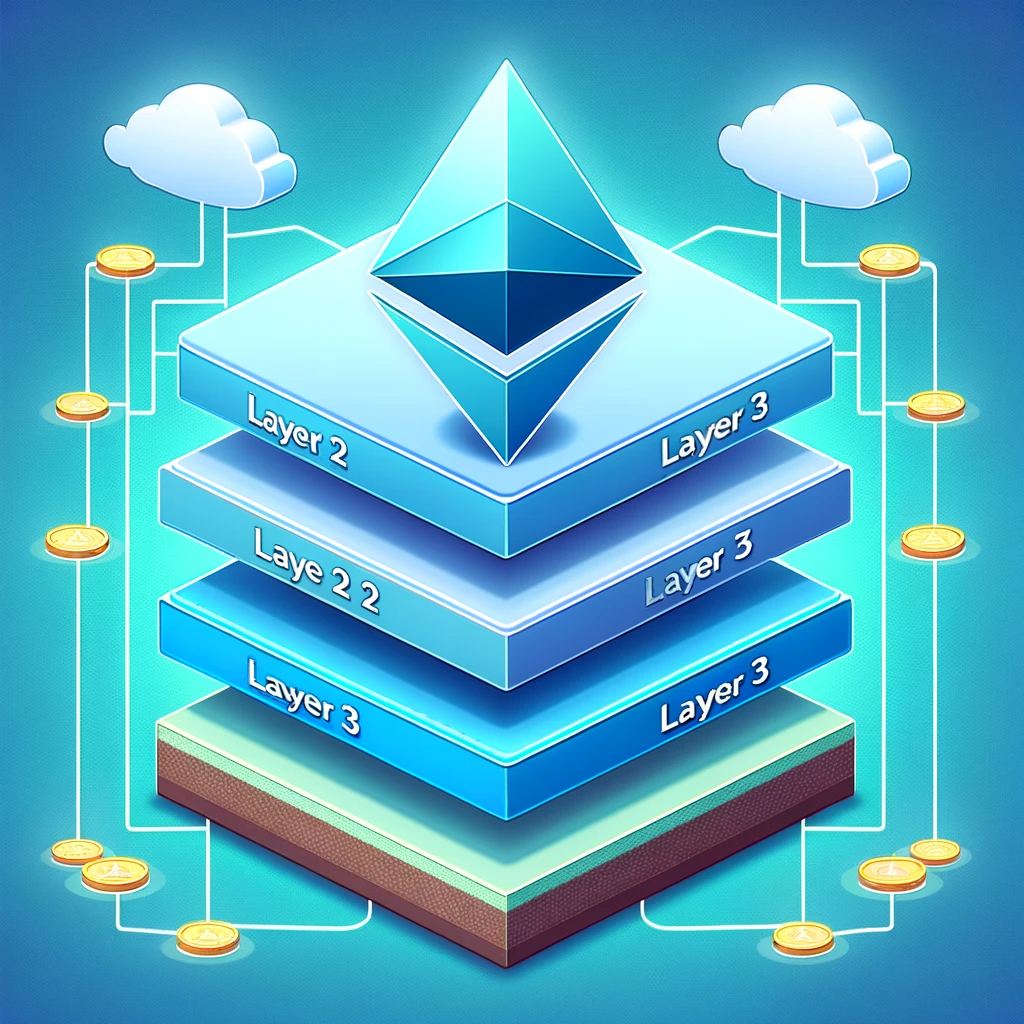Navigating Ethereum's Future: The Evolution of Layer 2 and Layer 3 Solutions

Blockbrainers
December 10, 2023
Introduction
In the ever-evolving world of blockchain technology, Ethereum has emerged as a cornerstone of innovation and a bedrock for decentralized applications (dApps). Yet, its success has brought forth significant challenges, primarily scalability, which has led to network congestion and high transaction fees. The advent of Layer 2 solutions has been a game-changer in this regard, offering a beacon of hope for scalability and efficiency. More recently, the concept of Layer 3 solutions has begun to take shape, promising even more advanced functionalities. This article delves into the intricacies of Ethereum Layer 2 and Layer 3 solutions, exploring their significance, functionality, and the key players driving this technological evolution.
Understanding Ethereum's Scalability Challenges
Ethereum's pioneering role in introducing smart contracts has led to a surge in its adoption. However, the network's capacity to handle the volume of transactions has been a growing concern. This limitation stems from Ethereum's design, which, while secure and decentralized, compromises on scalability. The result is a network that often becomes congested, leading to slower transaction processing and higher costs, thus limiting its potential for widespread use.
What are Ethereum Layer 2 Solutions?
Layer 2 solutions are innovative protocols built on top of Ethereum's main blockchain (Layer 1). They are designed to improve the network's ability to handle transactions by processing them off the main chain, thereby increasing transaction throughput, reducing costs, and enhancing transaction speed, all without compromising Ethereum's inherent security and decentralization.
The Critical Importance of Layer 2 Solutions
Enhanced Scalability: Layer 2 solutions address the fundamental challenge of Ethereum’s limited transaction capacity, enabling the network to handle a greater number of transactions.
Cost Reduction: These solutions significantly lower the transaction fees, commonly referred to as gas fees, by alleviating the burden on the main Ethereum chain.
Speed and Efficiency: Transactions processed on Layer 2 solutions are faster, offering a more efficient user experience, which is vital for Ethereum's broader adoption and success.
Maintaining Security and Decentralization: Despite off-chain transaction processing, Layer 2 solutions are designed to uphold Ethereum's core principles of security and decentralization.
Exploring the Mechanics of Layer 2 Solutions
Layer 2 technologies employ various methods to achieve scalability:
State Channels: These are off-chain channels where users can conduct numerous transactions among themselves. The final state of these transactions is then settled on the main Ethereum blockchain. State Channels are ideal for applications requiring high transaction throughput between a fixed set of participants.
Rollups: Rollups play a crucial role in Layer 2 solutions. They aggregate multiple transactions into a single transaction on the main chain, significantly reducing the network's load. There are two types of rollups:
Zero-Knowledge Rollups (ZK-Rollups): These utilize cryptographic proofs to validate transactions off-chain. They offer high security and efficiency, though they are complex to implement.
Optimistic Rollups: Operating under the assumption that all transactions are valid by default, they only run computations if a transaction is challenged. This approach increases efficiency but requires a period for potential challenges for security.
Plasma: This framework creates secondary chains (child chains) that are linked to the main Ethereum chain. These child chains handle transactions and smart contracts independently, periodically committing their state back to the main chain.
The Evolution of Layer 2 Solutions: Key Players and Technologies
Several projects and technologies have been at the forefront of Layer 2 solutions:
Optimism: Utilizing Optimistic Rollups, Optimism focuses on improving Ethereum's scalability and user experience while ensuring compatibility with existing smart contracts.
Arbitrum: Another leading player employing Optimistic Rollups, Arbitrum enhances Ethereum's transaction throughput and efficiency without sacrificing decentralization.
zkSync: Employing ZK-Rollups, zkSync emphasizes both scalability and security, offering lower transaction costs and increased throughput.
Polygon (Formerly Matic Network): Providing a range of scaling solutions, including Plasma and sidechains, Polygon has positioned itself as a versatile and comprehensive Layer 2 solution provider.
The Emerging Concept of Layer 3 Solutions
As the blockchain ecosystem continues to mature, the concept of Layer 3 solutions has started to emerge. These solutions are envisioned as complementary layers that build upon the functionalities of Layer 2, offering specialized services such as enhanced privacy, cross-chain interoperability, or specific use-case optimizations.
Layer 3 Solutions: Enhancing Functionality and Interoperability
Layer 3 technologies aim to provide solutions to some limitations of Layer 2, offering more targeted functionalities or advanced features:
Specialized Services: Layer 3 could offer services like private transactions or specific dApp functionalities that Layer 2 might not efficiently support.
Cross-Chain Interoperability: One of the most anticipated aspects of Layer 3 is its potential to facilitate seamless interactions between different blockchain networks, enhancing the interoperability of the blockchain ecosystem.
The Potential Future of Blockchain Scalability: Beyond Layer 2
The concept of Layer 3 is still in its infancy but represents the ongoing quest for scalability, efficiency, and functionality in blockchain technology. It exemplifies the dynamic nature of this field and the continuous pursuit of solutions that could eventually lead to a highly scalable, interoperable, and user-friendly blockchain ecosystem.
Conclusion
The development and implementation of Layer 2 solutions on Ethereum mark a pivotal moment in the blockchain's journey. They represent a significant stride towards solving the scalability trilemma – achieving scalability, security, and decentralization. As the blockchain community looks ahead, the nascent concept of Layer 3 solutions offers a glimpse into a future where blockchain technology is not only more scalable and efficient but also more versatile and interconnected.
In the grand scheme of things, Ethereum's evolution from Layer 1 to Layer 2, and the anticipation of Layer 3, reflect the vibrant and innovative spirit of the blockchain community. It's a journey of continuous improvement and adaptation, driven by a collaborative effort to overcome challenges and unlock new possibilities. For anyone involved in the blockchain space, staying informed and engaged with these developments is essential to understanding and shaping the future of this transformative technology.